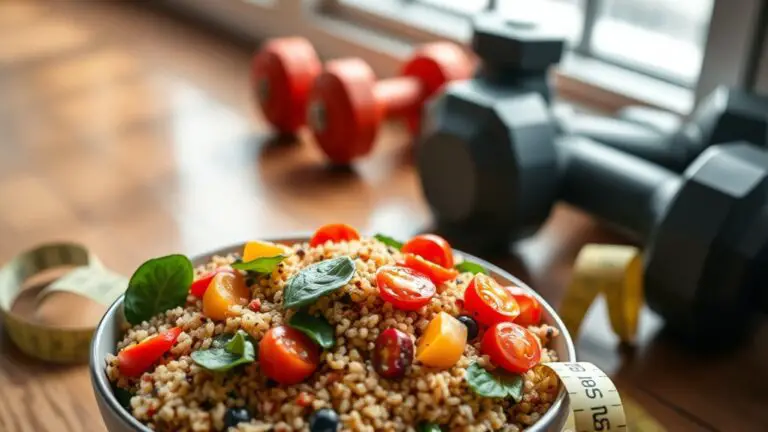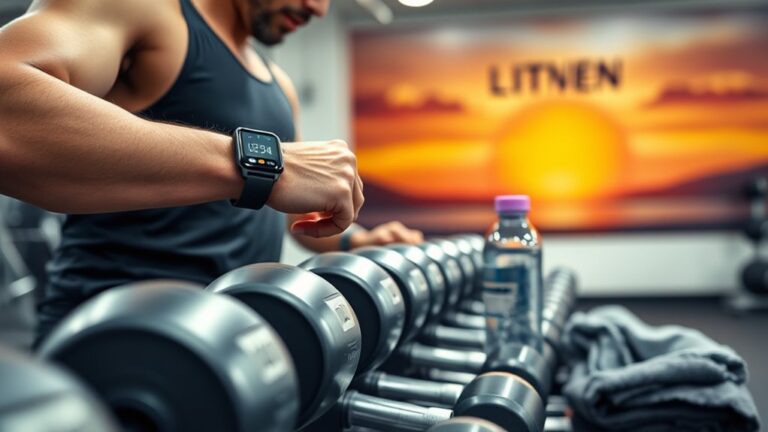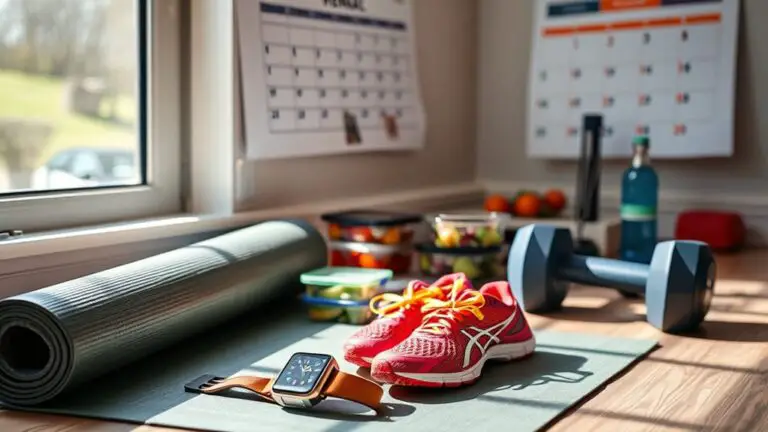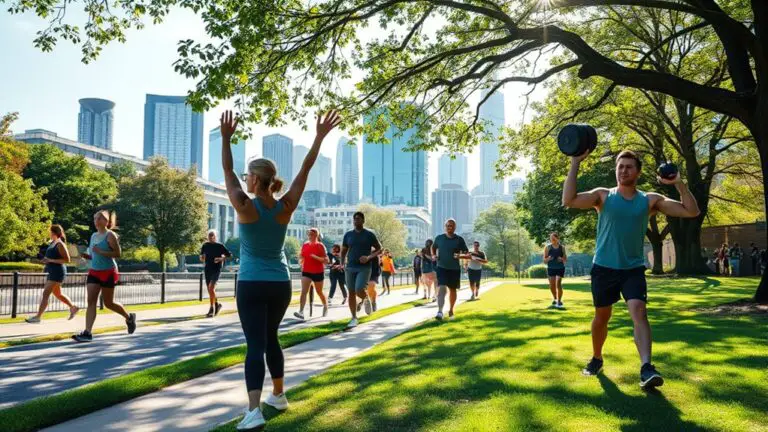How to Use Household Items as Gym Equipment
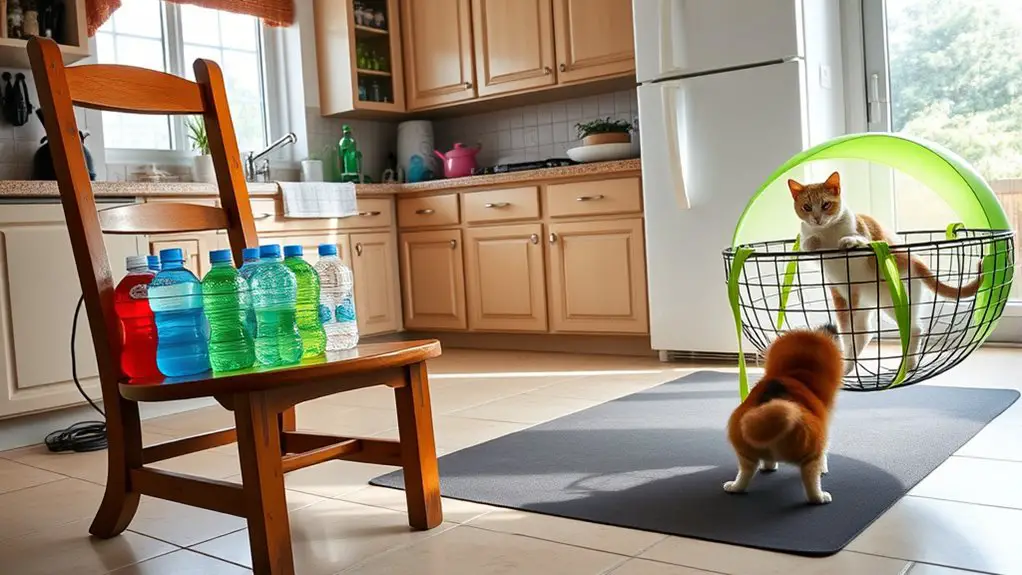
You can easily use household items as gym equipment for effective workouts. Canned goods or filled water bottles serve as weights for resistance training. A sturdy chair or low table can help with step workouts. For core strengthening, use a backpack filled with books. You can elevate your heart rate with a stair routine and incorporate a belt for stretches. If you want more tips on maximizing your home gear, there’s plenty more to explore.
DIY Weights: Using Cans and Bottles
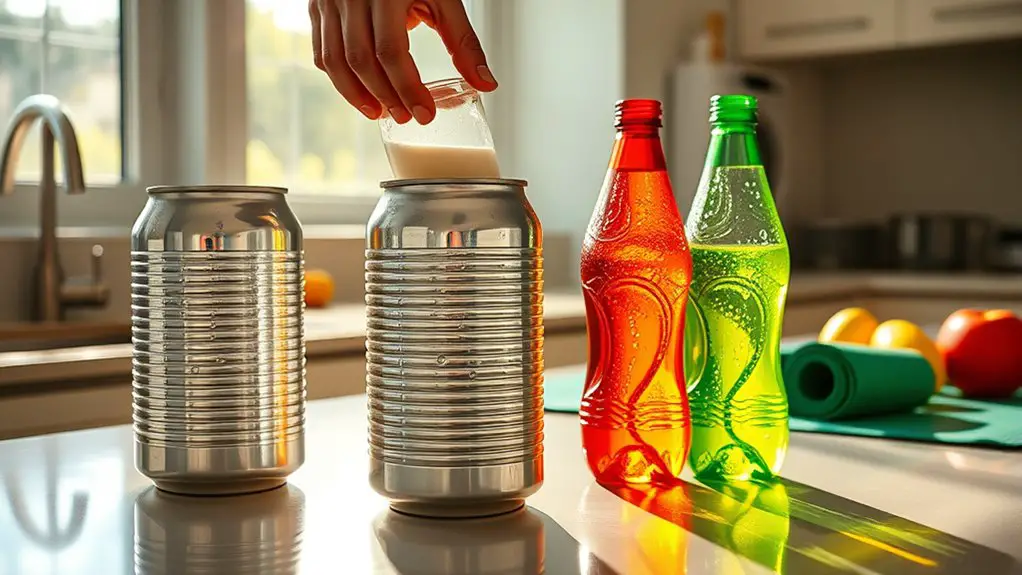
When you’re looking to add some weight to your workout without investing in expensive gym equipment, everyday items like cans and bottles can be surprisingly effective. Canned strength is a great way to incorporate resistance training at home. Grab a couple of canned goods; they typically weigh around one to two pounds each, making them perfect for bicep curls or shoulder presses.
Bottled resistance is another fantastic option. Fill empty water bottles with sand or rice for adjustable weight. Just make sure the lids are secure to avoid spills during your workout.
Always prioritize safety—start with lighter items and gradually increase the weight as your strength improves. Pay attention to your form to prevent strain or injury. With these household items, you can create a safe and effective workout routine without breaking the bank. Keep it simple, and enjoy the creativity of using what you have!
Resistance Training With Towels
Towels can be surprisingly effective for resistance training, and you don’t need any fancy equipment. You can try towel rows to strengthen your back, towel squats for your legs, and even core exercises that utilize the towel’s tension. Let’s explore how to incorporate these simple moves into your workout routine!
Towel Rows Technique
A simple yet effective way to engage your back muscles at home is through towel rows. Start by finding a sturdy door or post as your anchor point. Grab a towel and wrap it around the anchor, ensuring a secure towel grip. Stand a few feet away, holding the towel with both hands. Lean back slightly while keeping your body straight, then pull your body toward the anchor point, using towel resistance to challenge your muscles. Focus on squeezing your shoulder blades together as you row. Be cautious not to jerk or use momentum; smooth, controlled movements are key for safety. Aim for 10-15 repetitions, maintaining proper form throughout to prevent strain or injury. Enjoy your workout!
Towel Squats Variation
Using household items like towels can enhance your workout routine, and incorporating towel squats is a great way to strengthen your lower body. To perform towel squats, you’ll need to hold a towel in front of you, gripping it firmly. As you squat down, pull the towel to create towel resistance, which engages your muscles more effectively. Make sure your feet are shoulder-width apart for proper stability. Keep your back straight and your core tight to maintain towel stability throughout the movement. As you rise back up, focus on squeezing your glutes. This variation not only builds strength but also helps improve your balance. Remember to start slowly and listen to your body to avoid injury.
Core Exercises With Towels
While you might think of towels as simple household items, they can actually serve as effective tools for core exercises. For towel crunches, lie on your back with your knees bent and feet flat. Hold the ends of a towel above your head, then lift your shoulders off the ground while pulling the towel towards your knees. This engages your abs while providing resistance.
For towel planks, place a towel under your forearms and toes in a plank position. The towel adds a slight instability, making your core work harder to maintain balance. Remember to keep your body straight and engage your core throughout the exercise. As always, listen to your body to avoid strain and adjust your movements as needed.
Step Workouts With Sturdy Furniture
If you’ve got sturdy furniture at home, it can easily double as step workout equipment. Using safe and stable items, you can create effective step variations that elevate your heart rate and build strength. Here are three sturdy furniture pieces you can use for your workouts:
- Sturdy Chair: Verify it’s stable enough to support your weight as you step up and down, targeting your legs and glutes.
- Coffee Table: If it’s low to the ground, it can serve as a great platform for lateral step-ups. Just make certain it won’t tip over!
- Stairs: If you have stairs at home, they’re perfect for adding variety to your routine. Just be cautious and use the handrail for balance.
With these sturdy furniture options, you can safely incorporate step workouts into your routine. Always listen to your body and start at a comfortable pace!
Core Strengthening With a Backpack
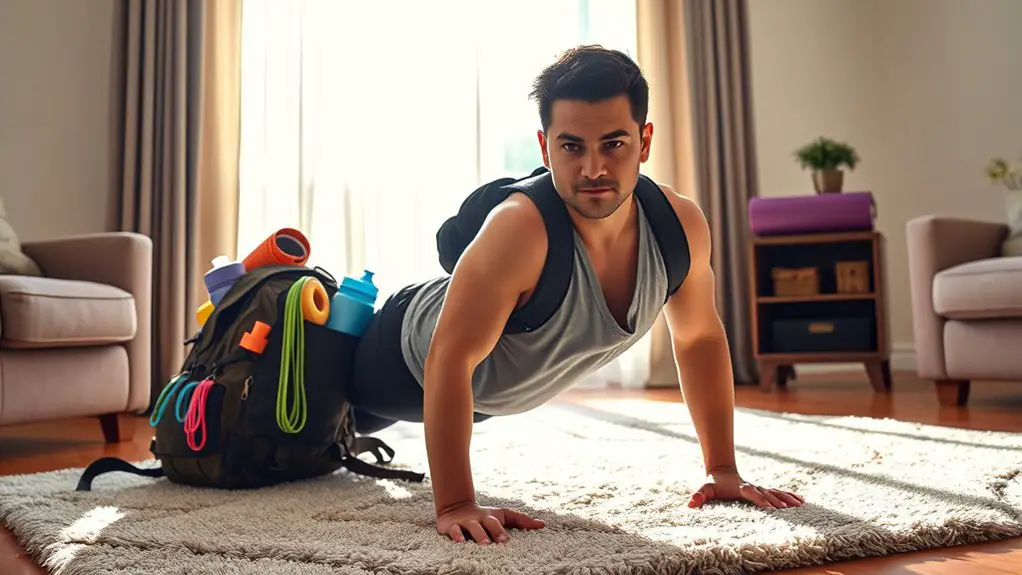
Using a backpack filled with household items can be a great way to strengthen your core. By adding weight, you can enhance the effectiveness of various core exercises. Let’s explore how to fill your backpack and some simple exercises you can do at home.
Filling the Backpack
One great way to enhance your core strength is by filling a backpack with household items. When you’re considering backpack weight, keep safety in mind—don’t overload it. Here are some effective filling techniques:
- Books: They’re heavy and can provide great resistance.
- Canned goods: These are manageable and easy to pack.
- Bottles of water: Fill them to control the weight exactly as you need.
Make sure to distribute the weight evenly to avoid strain. Start with a lighter load and gradually increase the weight as your core strength improves. This way, you’ll build stability and strength safely while using items you already have at home. Enjoy your workout with this simple, effective method!
Effective Core Exercises
While you might think a gym is necessary for effective core workouts, a filled backpack can serve as an excellent substitute. You can enhance your core strength by incorporating plank variations and bicycle crunches with the added weight. Just make sure your backpack is securely packed to avoid injury.
Here’s a simple guide to get you started:
| Exercise | Instructions |
|---|---|
| Plank Variations | Place the backpack on your back, hold a plank position for 30 seconds, switch to side planks. |
| Bicycle Crunches | Lie on your back, hold the backpack above your chest, and perform bicycle crunches for 15 repetitions. |
| Side Planks | Balance the backpack on your side while holding a side plank for 20 seconds. |
| Russian Twists | Sit with your feet elevated, hold the backpack, and twist your torso side to side for 15 reps. |
Always listen to your body and prioritize safety!
Cardio Blast With a Stairs Routine
If you’re looking to elevate your heart rate without any fancy gym equipment, a stairs routine can be a game-changer. You can easily incorporate stair sprints and step ups into your workout. Just remember to prioritize safety as you get started.
Elevate your heart rate with a simple stairs routine—no fancy gym equipment needed! Prioritize safety as you dive in.
Here’s a simple routine to follow:
- Stair Sprints: Run up and down the stairs for 30 seconds, focusing on quick, controlled movements.
- Step Ups: Use the bottom step to step up and down for 1 minute. This targets your legs and glutes while keeping your heart rate up.
- Active Recovery: Walk slowly on the stairs for 30 seconds after each sprint or step up to catch your breath.
Always keep your core engaged and maintain a steady pace to avoid injury. With these exercises, you’ll get a solid cardio workout right at home. Enjoy the sweat and feel the burn!
Balance Exercises Using a Chair
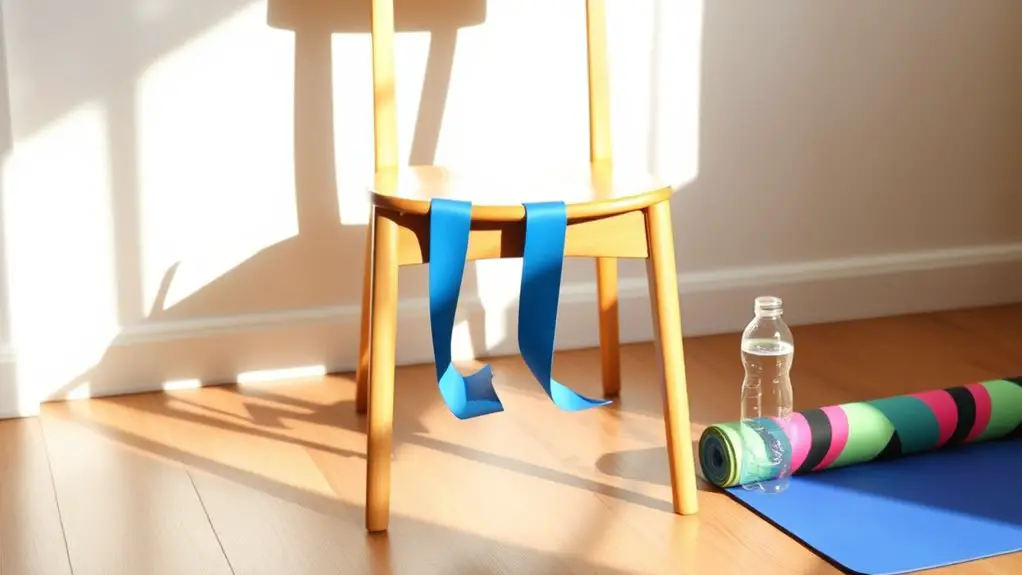
A chair can be your best friend when it comes to balance exercises. You can start with simple chair stability exercises to strengthen your core and improve your balance. Seated leg raises are another effective move that’ll keep you steady on your feet.
Chair Stability Exercises
Chair stability exercises are an excellent way to enhance your balance and core strength, especially if you’re looking for a low-impact option. Using a sturdy chair, you can safely engage in beneficial stability workouts that improve your overall fitness. Here are three effective chair exercises to try:
- Seated Marches: Sit tall and lift your knees alternately as if marching, keeping your core engaged.
- Chair Squats: Stand in front of the chair, lower yourself as if sitting, then rise back up, ensuring your knees don’t go past your toes.
- Side Leg Raises: While holding onto the chair for support, lift one leg to the side, keeping your body steady.
Incorporate these exercises into your routine for improved balance and strength!
Seated Leg Raises
Elevate your fitness routine with seated leg raises, a simple yet effective balance exercise that can be performed using a chair. Start by sitting tall in a sturdy chair, ensuring your feet are flat on the ground for stability. For seated variations, lift one leg straight out in front of you, holding for a few seconds before lowering it back down. Repeat this leg raise technique for each leg, aiming for 10-15 repetitions. To enhance safety, keep your core engaged and avoid leaning back. If you want more challenge, you can try raising both legs at once. Seated leg raises not only improve balance but also strengthen your legs, making them an excellent addition to your home workout routine.
Stretching and Flexibility With a Belt
While you might not think of a belt as a workout tool, it can be incredibly useful for enhancing your stretching and flexibility routine. Using a belt allows you to perform effective belt stretches that promote better flexibility and muscle relaxation. Here are three simple flexibility drills you can try:
A belt can elevate your stretching routine, enhancing flexibility and promoting muscle relaxation with simple, effective drills.
- Hamstring Stretch: Sit with your legs extended. Loop the belt around your feet and gently pull towards you, feeling the stretch in your hamstrings.
- Shoulder Stretch: Hold the belt above your head with both hands. Slowly pull it apart while lowering it behind your back, stretching your shoulders.
- Hip Flexor Stretch: Stand and place the belt around one foot while keeping the other leg straight behind you. Pull gently to deepen the stretch in your hip flexor.
Always remember to keep your movements controlled to avoid injury, and never force a stretch. Enjoy improving your flexibility safely!
Pilates With a Stability Ball Substitute
If you don’t have a stability ball at home, you can easily substitute it with a sturdy chair or a cushion for your Pilates workouts. These stability ball alternatives can help you maintain balance and engage your core effectively. When using a chair, make sure it’s stable and won’t slip; this keeps your movements safe and controlled.
For Pilates modifications, try seated exercises like the Seated Twist on a chair to work your obliques or use a cushion for floor exercises like the Bridge. The cushion adds a bit of instability, which can enhance your core engagement, similar to a stability ball.
Always listen to your body and adjust as needed, especially if you’re new to Pilates. By incorporating these household items, you can still enjoy a fulfilling workout while making certain of safety. Remember, the key is to stay mindful of your form and stability throughout each exercise.
High-Intensity Interval Training (HIIT) With Household Items
Incorporating household items into your workouts isn’t just limited to Pilates; you can also create an effective High-Intensity Interval Training (HIIT) routine with what you have at home. Using everyday items can enhance your HIIT circuits while keeping things safe and engaging. Here are three items you can use for household cardio:
- Chairs: Use them for step-ups or tricep dips.
- Bottles of Water: These can serve as weights for squats or lunges.
- Towels: Lay them down for sliding lunges or mountain climbers. Additionally, you can include low-impact alternatives to traditional exercises, which are beneficial for maintaining cardiovascular fitness.
Creative Cool Down: Using Blankets and Pillows
After an intense workout, it’s essential to cool down properly, and using blankets and pillows can make this process both comfortable and enjoyable. Start with some gentle blanket stretches to ease muscle tension. Lay down a soft blanket and stretch your legs out, reaching for your toes. This not only relaxes your body but also helps you focus on your breathing.
Next, incorporate pillow poses. Use a pillow for support while lying on your back, placing it under your knees to relieve lower back pressure. You can also sit up with a pillow behind your back for added comfort during seated forward bends.
These simple stretches allow you to unwind safely, promoting recovery without strain. Remember to breathe deeply and listen to your body, ensuring you’re not pushing beyond your limits. So grab your favorite blanket and pillows, and treat yourself to a relaxing cooldown after your workout!
Frequently Asked Questions
Can I Use Glass Jars as Weights Instead of Cans?
Yes, you can use glass jars as weights instead of cans! They can be effective workout alternatives, especially if you fill them with rice, beans, or water for added weight. Just make certain the jars are securely closed to prevent spills, and handle them carefully to avoid breaks. Start with lighter jars to guarantee your safety, gradually increasing the weight as you build strength. You’ll find they can enhance your workouts without needing traditional equipment!
How Do I Prevent Slipping When Using Towels for Resistance?
When you’re aiming for strength, slipping can feel like losing your grip on progress. To prevent slipping while using towels for resistance techniques, make sure your hands and feet are dry. Consider folding the towel to create a thicker grip, enhancing stability. You might also use a non-slip mat beneath you for added safety. With these towel grip adjustments, you’ll find your workout feels more secure, allowing you to focus on your goals without worry.
What Furniture Is Safest for Step Workouts?
When considering furniture types for step workouts, prioritize stability and sturdiness. A solid, low coffee table or a sturdy step stool can work well, but verify they won’t wobble or slide during your workout. Avoid using chairs or lightweight furniture, as they can tip over, posing a safety risk. Always check the weight capacity, and confirm your chosen piece is secure to keep your workout safe and effective.
How Much Weight Can a Backpack Hold for Core Exercises?
When considering how much weight a backpack can hold for core workouts, it’s important to prioritize safety. Typically, a well-constructed backpack can safely carry between 10 to 30 pounds, depending on your fitness level. Make sure you distribute the weight evenly to avoid strain. Start with lighter loads and gradually increase as you gain strength. Always listen to your body; if it feels uncomfortable, it’s best to lighten the backpack weight.
Are There Alternatives to Stairs for Cardio Workouts?
Looking for alternatives to stairs for cardio workouts? You can easily switch things up with outdoor cardio options like brisk walking, jogging, or biking. Bodyweight exercises like jumping jacks or high knees also elevate your heart rate without needing stairs. Just make sure you choose safe surfaces to prevent slips or injuries. Incorporating these alternatives can keep your routine fresh and effective while ensuring you stay injury-free. Don’t be afraid to mix things up!

